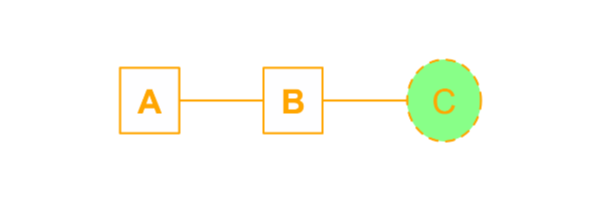

nomnoml provides an R interface to nomnoml.js, a tool for drawing sassy UML diagrams based on syntax with customizable styling.
Install from CRAN:
install.packages("nomnoml")Or from GitHub using:
install.packages("remotes")
remotes::install_github("rstudio/nomnoml")You need a chromium based browser installed on your system
In previous releases of nomnoml (prior to v0.3.0) we
used the phantom.js headless browser to capture
screenshots. In version 0.3.0 we switched to using
webshot2.
This means you need a chromium-based browser, e.g. Chromium itself, Chrome, Edge, Vivaldi, Brave, or Opera.
You can create your first diagram by running:
nomnoml::nomnoml("[Hello]-[World!]")
To make the diagram flow vertically, the default at nomnoml.com, add the direction directive:
#direction: down
[Hello]-[World!]
You can also use nomnoml in R Markdown:
---
title: "A Diagram"
output: html_document
---
```{r, setup, include=FALSE}
library(nomnoml)
```
```{nomnoml}
#stroke: orange
#.box: fill=#8f8 dashed visual=ellipse
[A]-[B]-[<box>C]
```
To render using SVG, add svg = TRUE
nomnoml(diagram, svg = TRUE)To render a nomnoml chunk in R Markdown, add
svg=TRUE to the chunk options
```{nomnoml, svg=TRUE}
#stroke: orange
#.box: fill=#8f8 dashed visual=ellipse
[A]-[B]-[<box>C]
```
Notice that much more complex diagrams can be designed using
nomnoml by combining association types, classifier types,
directives and custom classifier styles.
#stroke: #a86128
#direction: down
[<frame>Decorator pattern|
[<abstract>Component||+ operation()]
[Client] depends --> [Component]
[Decorator|- next: Component]
[Decorator] decorates -- [ConcreteComponent]
[Component] <:- [Decorator]
[Component] <:- [ConcreteComponent]
]
- association
-> association
<-> association
--> dependency
<--> dependency
-:> generalization
<:- generalization
--:> implementation
<:-- implementation
+- composition
+-> composition
o- aggregation
o-> aggregation
-o) ball and socket
o<-) ball and socket
->o ball and socket
-- note
-/- hidden
_> weightless edge
__ weightless dashed edge[name]
[<abstract> name]
[<instance> name]
[<reference> name]
[<note> name]
[<package> name]
[<frame> name]
[<database> name]
[<pipe> name]
[<start> name]
[<end> name]
[<state> name]
[<choice> name]
[<sync> name]
[<input> name]
[<lollipop> lollipop]
[<sender> name]
[<socket> socket]
[<receiver> name]
[<transceiver> name]
[<actor> name]
[<usecase> name]
[<label> name]
[<hidden> name]
[<table> name| a | 5 || b | 7]#import: my-common-styles.nomnoml
#arrowSize: 1
#bendSize: 0.3
#direction: down | right
#gutter: 5
#edgeMargin: 0
#gravity: 1
#edges: hard | rounded
#background: transparent
#fill: #eee8d5; #fdf6e3
#fillArrows: false
#font: Calibri
#fontSize: 12
#leading: 1.25
#lineWidth: 3
#padding: 8
#spacing: 40
#stroke: #33322E
#title: filename
#zoom: 1
#acyclicer: greedy
#ranker: network-simplex | tight-tree | longest-pathDirectives only available when using the command line interface
#import: my-common-styles.nomnomlA directive that starts with “.” define a classifier style.
#.box: fill=#88ff88
#.blob: fill=pink visual=ellipse italic bold dashed
[<box> GreenBox]
[<blob> HideousBlob]Available key/value pairs:
fill=(any css color)
stroke=(any css color)
align=center
align=left
direction=right
direction=down
visual=actor
visual=class
visual=database
visual=ellipse
visual=end
visual=frame
visual=hidden
visual=input
visual=none
visual=note
visual=package
visual=receiver
visual=rhomb
visual=roundrect
visual=sender
visual=start
visual=table
visual=transceiverAvailable modifiers are
center
bold
underline
italic
dashed
empty